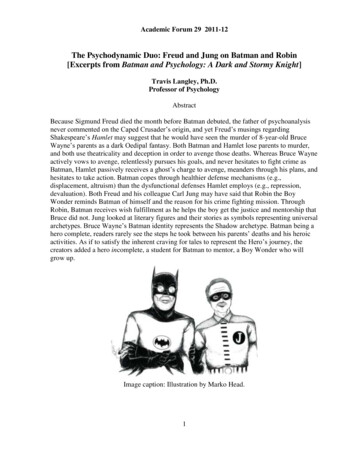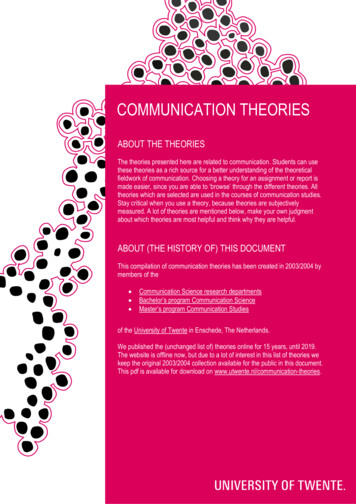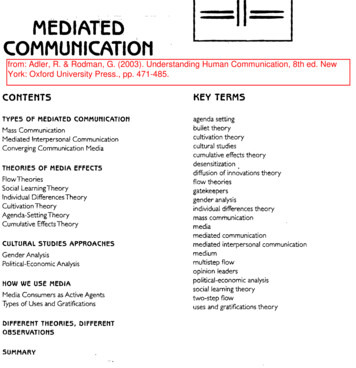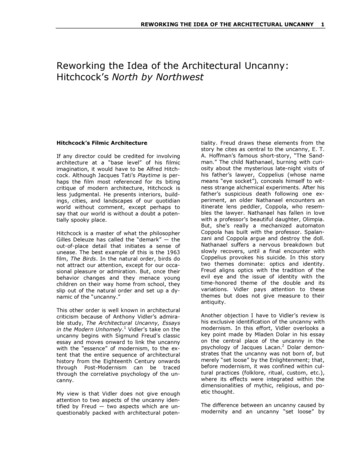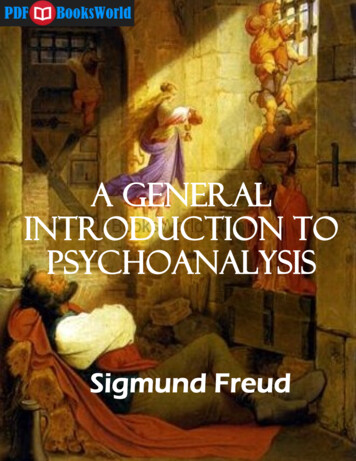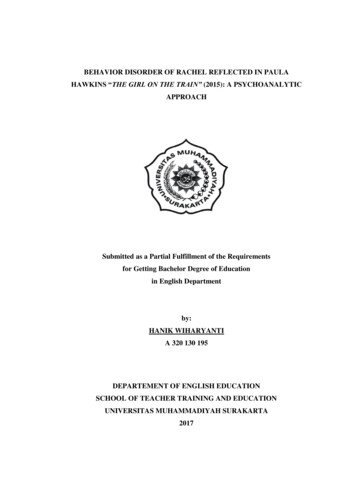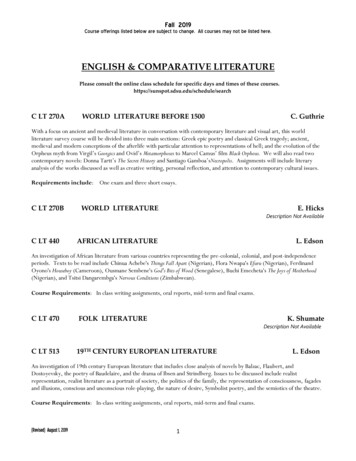![[Type Here] - Sigmund Freud:Theories,Biography,Quotes,Free .](/img/19/the-ego-and-the-id.jpg)
Transcription
[Type here]
ContentsI CONSCIOUSNESS AND WHAT IS UNCONSCIOUS .2II THE EGO AND THE ID .6III THE EGO AND THE SUPER-EGO (EGO IDEAL) .12IV THE TWO CLASSES OF INSTINCTS .20V THE DEPENDENT RELATIONSHIPS OF THE EGO .251Free eBook at www.SigmudFreud.net
THE EGO AND THE ID (1923)The present discussions are a further development of some trains of thought which I opened upin Beyond the Pleasure Principle (1920g), and to which, as I remarked there, my attitude wasone of a kind of benevolent curiosity. In the following pages these thoughts are linked tovarious facts of analytic observation and an attempt is made to arrive at new conclusions fromthis conjunction; in the present work, however, there are no fresh borrowings from biology,and on that account it stands closer to psycho-analysis than does Beyond the Pleasure Principle.It is more in the nature of a synthesis than of a speculation and seems to have had an ambitiousaim in view. I am conscious, however, that it does not go beyond the roughest outline and withthat limitation I am perfectly content.In these pages things are touched on which have not yet been the subject of psycho-analyticconsideration, and it has not been possible to avoid trenching upon some theories which havebeen put forward by non-analysts or by former analysts on their retreat from analysis. I haveelsewhere always been ready to acknowledge what I owe to other workers; but in this instanceI feel burdened by no such debt of gratitude. If psycho-analysis has not hitherto shown itsappreciation of certain things, this has never been because it overlooked their achievement orsought to deny their importance, but because it followed a particular path, which had not yetled so far. And finally, when it has reached them, things have a different look to it from whatthey have to others.I CONSCIOUSNESS AND WHAT IS UNCONSCIOUSIn this introductory chapter there is nothing new to be said and it will not be possible to avoidrepeating what has often been said before. The division of the psychical into what is consciousand what is unconscious is the fundamental premiss of psycho-analysis; and it alone makes itpossible for psycho-analysis to understand the pathological processes in mental life, which areas common as they are important, and to find a place for them in the framework of science. Toput it once more, in a different way: psycho-analysis cannot situate the essence of the psychicalin consciousness, but is obliged to regard consciousness as a quality of the psychical, which maybe present in addition to other qualities or may be absent.2Free eBook at www.SigmudFreud.net
If I could suppose that everyone interested in psychology would read this book, I should also beprepared to find that at this point some of my readers would already stop short and would gono further; for here we have the first shibboleth of psycho-analysis. To most people who havebeen educated in philosophy the idea of anything psychical which is not also conscious is soinconceivable that it seems to them absurd and refutable simply by logic. I believe this is onlybecause they have never studied the relevant phenomena of hypnosis and dreams, which quite apart from pathological manifestations -necessitate this view. Their psychology ofconsciousness is incapable of solving the problems of dreams and hypnosis.Being conscious‘ is in the first place a purely descriptive term, resting on perception of themost immediate and certain character. Experience goes on to show that a psychical element(for instance, an idea) is not as a rule conscious for a protracted length of time. On the contrary,a state of consciousness is characteristically very transitory; an idea that is conscious now is nolonger so a moment later, although it can become so again under certain conditions that areeasily brought about. In the interval the idea was - we do not know what. We can say that itwas latent, and by this we mean that it was capable of becoming conscious at any time. Or, ifwe say that is was unconscious, we shall also be giving a correct description of it. Hereunconscious‘ coincides with latent and capable of becoming conscious‘. The philosopherswould no doubt object: No, the term "unconscious" is not applicable here; so long as the ideawas in a state of latency it was not anything psychical at all.‘ To contradict them at this pointwould lead to nothing more profitable than a verbal dispute.But we have arrived at the term or concept of the unconscious along another path, byconsidering certain experiences in which mental dynamics play a part. We have found - that is,we have been obliged to assume - that very powerful mental processes or ideas exist (and herea quantitative or economic factor comes into question for the first time) which can produce allthe effects in mental life that ordinary ideas do (including effects that can in their turn becomeconscious as ideas), though they themselves do not become conscious. It is unnecessary torepeat in detail here what has been explained so often before. It is enough to say that at thispoint psycho-analytic theory steps in and asserts that the reason why such ideas cannotbecome conscious is that a certain force opposes them, that otherwise they could becomeconscious, and that it would then be apparent how little they differ from other elements whichare admittedly psychical. The fact that in the technique of psycho-analysis a means has beenfound by which the opposing force can be removed and the ideas in question made consciousrenders this theory irrefutable. The state in which the ideas existed before being madeconscious is called by us repression, and we assert that the force which instituted therepression and maintains it is perceived as resistance during the work of analysisThus we obtain our concept of the unconscious from the theory of repression. The repressed isthe prototype of the unconscious for us. We see, however, that we have two kinds of3Free eBook at www.SigmudFreud.net
unconscious - the one which is latent but capable of becoming conscious, and the one which isrepressed and which is not, in itself and without more ado, capable of becoming conscious. Thispiece of insight into psychical dynamics cannot fail to affect terminology and description. Thelatent, which is unconscious only descriptively, not in the dynamic sense, we call preconscious;we restrict the term unconscious to the dynamically unconscious repressed; so that now wehave three terms, conscious (Cs.), preconscious (Pcs.), and unconscious (Ucs.), whose sense isno longer purely descriptive. The Pcs. is presumably a great deal closer to the Cs. than is theUcs., and since we have called the Ucs. psychical we shall with even less hesitation call thelatent Pcs. psychical. But why do we not rather, instead of this, remain in agreement with thephilosophers and, in a consistent way, distinguish the Pcs. as well as the Ucs. from theconscious psychical? The philosophers would then propose that the Pcs. and the Ucs. should bedescribed as two species or stages of the psychoid‘, and harmony would be established. Butend less difficulties in exposition would follow; and the one important fact, that these two kindsof psychoid‘ coincide in almost every other respect with what is admittedly psychical, would beforced into the background in the interests of a prejudice dating from a period in which thesepsychoids, or the most important part of them, were still unknown.We can now play about comfortably with our three terms, Cs., Pcs., and Ucs., so long as we donot forget that in the descriptive sense there are two kinds of unconscious, but in the dynamicsense only one. For purposes of exposition this distinction can in some cases be ignored, but inothers it is of course indispensable. At the same time, we have become more or lessaccustomed to this ambiguity of the unconscious and have managed pretty well with it. As faras I can see, it is impossible to avoid this ambiguity; the distinction between conscious andunconscious is in the last resort a question of perception, which must be answered yes‘ or no‘,and the act of perception itself tells us nothing of the reason why a thing is or is not perceived.No one has a right to complain because the actual phenomenon expresses the dynamic factorambiguously.¹¹ This may be compared so far with my Note on the Unconscious in Psycho-Analysis‘ (1912g). Anew turn taken by criticisms of the unconscious deserves consideration at this point. Someinvestigators, who do not refuse to recognize the facts of psycho-analysis but who are unwillingto accept the unconscious, find a way out of the difficulty in the fact, which no one contests,that in consciousness (regarded as a phenomenon) it is possible to distinguish a great variety ofgradations in intensity or clarity. Just as there are processes which are very vividly, glaringly,and tangibly conscious, so we also experience others which are only faintly, hardly evennoticeably conscious; those that are most faintly conscious are, it is argued, the ones to whichpsycho-analysis wishes to apply the unsuitable name unconscious‘. These too, however (theargument proceeds), are conscious or in consciousness‘, and can be made fully and intenselyconscious if sufficient attention is paid to them.4Free eBook at www.SigmudFreud.net
In so far as it is possible to influence by arguments the decision of a question of this kind whichdepends either on convention or on emotional factors, we may make the following comments.The reference to gradations of clarity in consciousness is in no way conclusive and has no moreevidential value than such analogous statements as: There are so very many gradations inillumination - from the most glaring and dazzling light to the dimmest glimmer - therefore thereis no such thing as darkness at all‘; or, There are varying degrees of vitality, therefore there isno such thing as death.‘ Such statements may in a certain way have a meaning, but for practicalpurposes they are worthless. This will be seen if one tries to draw particular conclusions fromthem, such as, there is therefore no need to strike a light‘, or, therefore all organisms areimmortal‘. Further, to include what is unnoticeable‘ under the concept of what is conscious‘ issimply to play havoc with the one and only piece of direct and certain knowledge that we haveabout the mind. And after all, a consciousness of which one knows nothing seems to me a gooddeal more absurd than something mental that is unconscious. Finally, this attempt to equatewhat is unnoticed with what is unconscious is obviously made without taking into account thedynamic conditions involved, which were the decisive factors in forming the psycho-analyticview. For it ignores two facts: first, that it is exceedingly difficult and requires very great effortto concentrate enough attention on something unnoticed of this kind; and secondly, that whenthis has been achieved the thought which was previously unnoticed is not recognized byconsciousness, but often seems entirely alien and opposed to it and is promptly disavowed byit. Thus, seeking refuge from the unconscious in what is scarcely noticed or unnoticed is after allonly a derivative of the preconceived belief which regards the identity of the psychical and theconscious as settled once and for all.In the further course of psycho-analytic work, however, even these distinctions have proved tobe inadequate and, for practical purposes, insufficient. This has become clear in more waysthan one; but the decisive instance is as follows. We have formed the idea that in eachindividual there is a coherent organization of mental processes; and we call this his ego. It is tothis ego that consciousness is attached; the ego controls the approaches to motility - that is, tothe discharge of excitations into the external world; it is the mental agency which supervises allits own constituent processes, and which goes to sleep at night, though even then it exercisesthe censorship on dreams. From this ego proceed the repressions, too, by means of which it issought to exclude certain trends in the mind not merely from consciousness but also fromother forms of effectiveness and activity. In analysis these trends which have been shut outstand in opposition to the ego, and the analysis is faced with the task of removing theresistances which the ego displays against concerning itself with the repressed. Now we findduring analysis that, when we put certain tasks before the patient, he gets into difficulties; hisassociations fail when they should be coming near the repressed. We then tell him that he isdominated by a resistance; but he is quite unaware of the fact, and, even if he guesses from his5Free eBook at www.SigmudFreud.net
unpleasurable feelings that a resistance is now at work in him, he does not know what it is orhow to describe it. Since, however, there can be no question but that this resistance emanatesfrom his ego and belongs to it, we find ourselves in an unforeseen situation. We have comeupon something in the ego itself which is also unconscious, which behaves exactly like therepressed - that is, which produces powerful effects without itself being conscious and whichrequires special work before it can be made conscious. From the point of view of analyticpractice, the consequence of this discovery is that we land in endless obscurities and difficultiesif we keep to our habitual forms of expression and try, for instance, to derive neuroses from aconflict between the conscious and the unconscious. We shall have to substitute for thisantithesis another, taken from our insight into the structural conditions of the mind - theantithesis between the coherent ego and the repressed which is split off from it.¹For our conception of the unconscious, however, the consequences of our discovery are evenmore important. Dynamic considerations caused us to make our first correction; our insight intothe structure of the mind leads to the second. We recognize that the Ucs. does not coincidewith the repressed; it is still true that all that is repressed is Ucs., but not all that is Ucs. isrepressed. A part of the ego, too - and Heaven knows how important a part - may be Ucs.,undoubtedly is Ucs. And this Ucs. belonging to the ego is not latent like the Pcs.; for if it were, itcould not be activated without becoming Cs., and the process of making it conscious would notencounter such great difficulties. When we find ourselves thus confronted by the necessity ofpostulating a third Ucs., which is not repressed, we must admit that the characteristic of beingunconscious begins to lose significance for us. It becomes a quality which can have manymeanings, a quality which we are unable to make, as we should have hoped to do, the basis offarreaching and inevitable conclusions. Nevertheless we must beware of ignoring thischaracteristic, for the property of being conscious or not is in the last resort our one beaconlight in the darkness of depth-psychology.II THE EGO AND THE IDPathological research has directed our interest too exclusively to the repressed. We should liketo learn more about the ego, now that we know that it, too, can be unconscious in the propersense of the word. Hitherto the only guide we have had during our investigations has been thedistinguishing mark of being conscious or unconscious; we have finally come to see howambiguous this can be. Now all our knowledge is invariably bound up with consciousness. Wecan come to know even the Ucs, only by making it conscious. But stop, how is that possible?What does it mean when we say making something conscious‘? How can that come about?We already know the point from which we have to start in this connection. We have said thatconsciousness is the surface of the mental apparatus; that is, we have ascribed it as a function6Free eBook at www.SigmudFreud.net
to a system which is spatially the first one reached from the external world - and spatially notonly in the functional sense but, on this occasion, also in the sense of anatomical dissection.¹Our investigations too must take this perceiving surface as a starting-point.All perceptions which are received from without (sense-perceptions) and from within - whatwe call sensations and feelings - are Cs. from the start. But what about those internal processeswhich we may - roughly and inexactly - sum up under the name of thought-processes? Theyrepresent displacements of mental energy which are effected somewhere in the interior of theapparatus as this energy proceeds on its way towards action. Do they advance to the surface,which causes consciousness to be generated? Or does consciousness make its way to them?This is clearly one of the difficulties that arise when one begins to take the spatial ortopographical‘ idea of mental life seriously. Both these possibilities are equally unimaginable,there must be a third alternative.I have already, in another place,¹ suggested that the real difference between a Ucs. and a Pcs.idea (thought) consists in this: that the former is carried out on some material which remainsunknown, whereas the latter (the Pcs.) is in addition brought into connection with wordpresentations. This is the first attempt to indicate distinguishing marks for the two systems, thePcs. and the Ucs., other than their relation to consciousness. The question, How does a thingbecome conscious?‘ would thus be more advantageously stated: How does a thing becomepreconscious?‘ And the answer would be: Through becoming connected with the wordpresentations corresponding to it.‘These word-presentations are residues of memories; they were at one time perceptions, andlike all mnemic residues they can become conscious again. Before we concern ourselves furtherwith their nature, it dawns upon us like a new discovery that only something which has oncebeen a Cs. perception can become conscious, and that anything arising from within (apart fromfeelings) that seeks to become conscious must try to transform itself into external perceptions:this becomes possible by means of memory-traces.We think of the mnemic residues as being contained in systems which are directly adjacent tothe system Pcpt.-Cs., so that the cathexes of those residues can readily extend from within onto the elements of the latter system. We immediately think here of hallucinations, and of thefact that the most vivid memory is always distinguishable both from a hallucination and from anexternal perception; but it will also occur to us at once that when a memory is revived thecathexis remains in the mnemic system, whereas a hallucination, which is not distinguishablefrom a perception, can arise when the cathexis does not merely spread over from the memorytrace on to the Pcpt. element, but passes over to it entirely.7Free eBook at www.SigmudFreud.net
Verbal residues are derived primarily from auditory perceptions, so that the system Pcs. has, asit were, a special sensory source. The visual components of word-presentations are secondary,acquired through reading, and may to begin with be left on one side; so may the motor imagesof words, which, except with deaf-mutes, play the part of auxiliary indications. In essence aword is after all the mnemic residue of a word that has been heard.We must not be led, in the interests of simplification perhaps, to forget the importance ofoptical mnemic residues, when they are of things, or to deny that it is possible for thoughtprocesses to become conscious through a reversion to visual residues, and that in many peoplethis seems to be the favoured method. The study of dreams and of preconscious phantasies asshown in Varendonck‘s observations can give us an idea of the special character of this visualthinking. We learn that what becomes conscious in it is as a rule only the concrete subjectmatter of the thought, and that the relations between the various elements of this subjectmatter, which is what specially characterizes thoughts, cannot be given visual expression.Thinking in pictures is, therefore, only a very incomplete form of becoming conscious. In someway, too, it stands nearer to unconscious processes than does thinking in words, and it isunquestionably older than the latter both ontogenetically and phylogenetically.To return to our argument: if, therefore, this is the way in which something that is in itselfunconscious becomes preconscious, the question how we make something that is repressed(pre)conscious would be answered as follows. It is done by supplying Pcs. intermediate linksthrough the work of analysis. Consciousness remains where it is, therefore; but, on the otherhand, the Ucs. does not rise into the Cs.Whereas the relation of external perceptions to the ego is quite perspicuous, that of internalperceptions to the ego requires special investigation. It gives rise once more to a doubtwhether we are really right in referring the whole of consciousness to the single superficialsystem Pcpt-Cs.Internal perceptions yield sensations of processes arising in the most diverse and certainly alsoin the deepest strata of the mental apparatus. Very little is known about these sensations andfeelings; those belonging to the pleasureunpleasure series may still be regarded as the bestexamples of them. They are more primordial, more elementary, than perceptions arisingexternally and they can come about even when consciousness is clouded. I have elsewhereexpressed my views about their greater economic significance and the metapsychologicalreasons for this. These sensations are multilocular, like external perceptions; they may comefrom different places simultaneously and may thus have different or even opposite qualities.Sensations of a pleasurable nature have not anything inherently impelling about them,whereas unpleasurable ones have it in the highest degree. The latter impel towards change,8Free eBook at www.SigmudFreud.net
towards discharge, and that is why we interpret unpleasure as implying a heightening andpleasure a lowering of energic cathexis. Let us call what becomes conscious as pleasure andunpleasure a quantitative and qualitative something‘ in the course of mental events; thequestion then is whether this something‘ can become conscious in the place where it is, orwhether it must first be transmitted to the system Pcpt.Clinical experience decides for the latter. It shows us that this something‘ behaves like arepressed impulse. It can exert driving force without the ego noticing the compulsion. Not untilthere is resistance to the compulsion, a holdup in the discharge-reaction, does thesomething‘ at once become conscious as unpleasure. In the same way that tensions arisingfrom physical needs can remain unconscious, so also can pain - a thing intermediate betweenexternal and internal perception, which behaves like an internal perception even when itssource is in the external world. It remains true, therefore, that sensations and feelings, too,only become conscious through reaching the system Pcpt.; if the way forward is barred, they donot come into being as sensations, although the something‘ that corresponds to them in thecourse of excitation is the same as if they did. We then come to speak, in a condensed and notentirely correct manner, of unconscious feelings‘, keeping up an analogy with unconsciousideas which is not altogether justifiable. Actually the difference is that, whereas with Ucs ideasconnecting links must be created before they can be brought into the Cs., with feelings, whichare themselves transmitted directly, this does not occur. In other words: the distinctionbetween Cs. and Pcs, has no meaning where feelings are concerned; the Pcs. here drops out and feelings are either conscious or unconscious. Even when they are attached to wordpresentations, their becoming conscious is not due to that circumstance, but they become sodirectly.The part played by word-presentations now becomes perfectly clear. By their interpositioninternal thoughtprocesses are made into perceptions. It is like a demonstration of the theoremthat all knowledge has its origin in external perception. When a hypercathexis of the process ofthinking takes place, thoughts are actually perceived - as if they came from without and areconsequently held to be true.After this clarifying of the relations between external and internal perception and thesuperficial system Pcpt.-Cs., we can go on to work out our idea of the ego. It starts out, as wesee, from the system Pcpt., which is its nucleus, and begins by embracing the Pcs., which isadjacent to the mnemic residues. But, as we have learnt, the ego is also unconscious.Now I think we shall gain a great deal by following the suggestion of a writer who, frompersonal motives, vainly asserts that he has nothing to do with the rigours of pure science. I amspeaking of Georg Groddeck, who is never tired of insisting that what we call our ego behaves9Free eBook at www.SigmudFreud.net
essentially passively in life, and that, as he expresses it, we are lived‘ by unknown anduncontrollable forces.¹We have all had impressions of the same kind, even though they may nothave overwhelmed us to the exclusion of all others, and we need feel no hesitation in finding aplace for Groddeck‘s discovery in the structure of science. I propose to take it into account bycalling the entity which starts out from the system Pcpt. and begins by being Pcs. the ego‘, andby following Groddeck in calling the other part of the mind, into which this entity extends andwhich behaves as though it were Ucs., the id‘.We shall soon see whether we can derive any advantage from this view for purposes either ofdescription or of understanding. We shall now look upon an individual as a psychical id,unknown and unconscious, upon whose surface rests the ego, developed from its nucleus thePcpt. system. If we make an effort to represent this pictorially, we may add that the ego doesnot completely envelop the id, but only does so to the extent to which the system Pcpt. formsits surface, more or less as the germinal disc rests upon the ovum. The ego is not sharplyseparated from the id; its lower portion merges into it.But the repressed merges into the id as well, and is merely a part of it. The repressed is onlycut off sharply from the ego by the resistances of repression; it can communicate with the egothrough the id. We at once realize that almost all the lines of demarcation we have drawn atthe instigation of pathology relate only to the superficial strata of the mental apparatus - theonly ones known to us. The state of things which we have been describing can be representeddiagrammatically (Fig. 1); though it must be remarked that the form chosen has no pre tensionsto any special applicability, but is merely intended to serve for purposes of exposition.Fig. 1.We might add, perhaps, that the ego wears a cap of hearing‘ - on one side only, as we learnfrom cerebral anatomy. It might be said to wear it awry.It is easy to see that the ego is that part of the id which has been modified by the directinfluence of the external world through the medium of the Pcpt.-Cs.; in a sense it is anextension of the surface-differentiation. Moreover, the ego seems to bring the influence of theexternal world to bear upon the id and its tendencies, and endeavours to substitute the realityprinciple for the pleasure principle which reigns unrestrictedly in the id. For the ego, perceptionplays the part which in the id falls to instinct. The ego represents what may be called reasonand common sense, in contrast to the id, which contains the passions. All this falls into line withpopular distinctions which we are all familiar with; at the same time, however, it is only to beregarded as holding good on the average or ideally‘.The functional importance of the ego is manifested in the fact that normally control over theapproaches to motility devolves upon it. Thus in its relation to the id it is like a man on horse10Free eBook at www.SigmudFreud.net
back, who has to hold in check the superior strength of the horse; with this difference, that therider tries to do so with his own strength while the ego uses borrowed forces. The analogy maybe carried a little further. Often a rider, if he is not to be parted from his horse, is obliged toguide it where it wants to go; so in the same way the ego is in the habit of transforming the id‘swill into action as if it were its own.Another factor, besides the influence of the system Pcpt., seems to have played a part inbringing about the formation of the ego and its differentiation from the id. A person‘s ownbody, and above all its surface, is a place from which both external and internal perceptionsmay spring. It is seen like any other object, but to the touch it yields two kinds of sensations,one of which may be equivalent to an internal perception. Psycho-physiology has fullydiscussed the manner in which a person‘s own body attains its special position among otherobjects in the world of perception. Pain, too, seems to play a part in the process, and the way inwhich we gain new knowledge of our organs during painful illnesses is perhaps a model of theway by which in general we arrive at the idea of our body.The ego is first and foremost a bodily ego; it is not merely a surface entity, but is itself theprojection of a surface. If we wish to find an anato
Free eBook at www.SigmudFreud.net THE EGO AND THE ID (1923) The present discussions are a further development of some trains of thought which I opened up in Beyond the Pleasure Principle (1920g), and to which, as I remarked there, my attitude was one of a kind of benevolent curio

